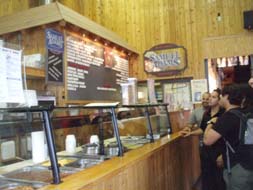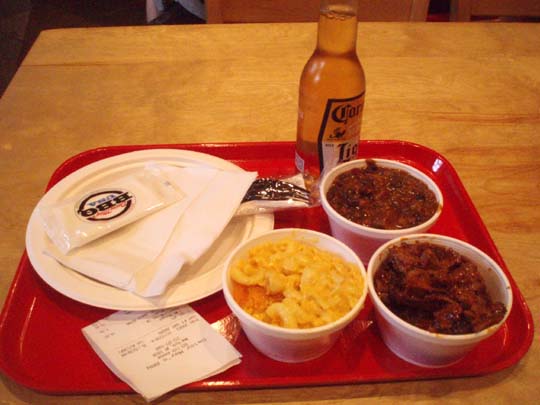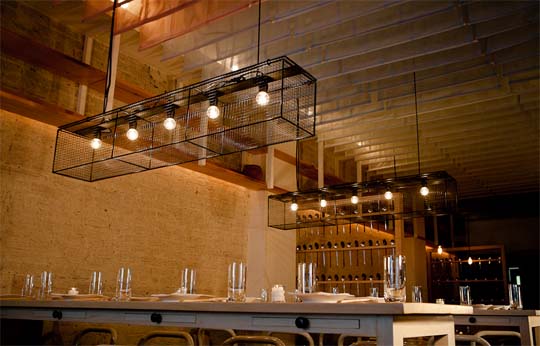
 Is there a “right way” to ration access to a popular restaurant? Our experience at Danji last weekend makes me wonder about that. (If you don’t want to read a rant about getting seated, page down to the asterisk below.)
Is there a “right way” to ration access to a popular restaurant? Our experience at Danji last weekend makes me wonder about that. (If you don’t want to read a rant about getting seated, page down to the asterisk below.)
Danji doesn’t take reservations, which is hardly a novelty in the casual dining scene. But many such places will at least take a phone number, and offer to phone or text when space frees up. Danji won’t even do that. The frequently-disappearing hostess quoted us a 30–45 minute wait, although it later became clear this was extremely optimistic.
“Can we put in our name?”
“What’s your name?”
“Marc.”
“OK, Marc.” She said it quickly and darted away, obviously not writing it down, not keeping a list, or offering to call whan a table freed up.
Had we elected to wait, there is nothing to do but stand against the wall in the narrow slip of a restaurant, as many do. (It’s even worse down the street at Totto Ramen, where a long line snakes out the door.) Instead, we hiked over to Ardesia for wine and crab dip (excellent!).
When we returned, about an hour later, we found the situation not much changed. A 2-top was vacant, and the hostess was nowhere to be seen. When she re-appeared, she gave it to a party whom she said had been waiting an hour; no indication of where we stood on the (non-existent) list.
We were ready to pack it in after another 20 minutes, before she finally seated us. At least we got one of the few tables, where the banquettes are comfortable (although very cramped) and the chairs have backs. Most of the seating is on stools at the bar or a communal table.
I don’t usually spill so much ink on the process of getting admitted to a restaurant, but we thought the service here was particularly poor—even within the context (with which I do not disapprove) of the no-reservations business model.
*
Having said all that, once you finally make it in here, the food is fine. It is not, in my opinion, good enough to justify the effort of getting in, especially as there aren’t any good bars nearby, where you can cool your heals. (Ardesia is a long walk.) But plenty of people endure the wait every day. Their priorities must be different than mine.
The chef here, Hooni Kim, has a distinguished pedigree, with brief stints (or stages?) at Daniel and Masa. He serves Korean small plates, designed for sharing, in a style somewhat resembling Momofuku Ssäm Bar, but the menu is more static and not nearly as good.
The plates are in two categories, Traditional and Modern, with about ten choices for each, $8–20 apiece (most in the $10–15 range). The menu has the usual nods to sourcing, with shout-outs for Satur Farms, Creekstone Farms, Niman Ranch, and Bell & Evans.
The server suggested that four to six plates was about right for two people, and that we could start small and order more later on. Kudos, at least, for that last bit: most places of this ilk ask for the whole order at once. It takes a while to get seated, but once you’re in they are in no hurry to push you out the door.
And to their credit, the four items we ordered came out in a sensible sequence, one at a time, as opposed to the dreaded “as-and-when they’re ready”; but the sharing plates were not replaced.
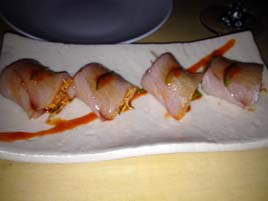

The first two dishes were from the “Modern” section of the menu. Spicy yellowtail sashimi ($15; above left) packed delightful heat from jalapeño and chochang, which (according to Wikipedia) is “a savory and pungent fermented Korean condiment made from red chili, glutinous rice, fermented soybeans and salt.”
Bossam ($20; above right) would impress you, unless you’d had the much better version of it at Momofuku Ssäm Bar. The idea remains the same: braised pork, scallions, daikon, and cabbage wrap. The pork was terrific, but you get only six bites of it for $20.
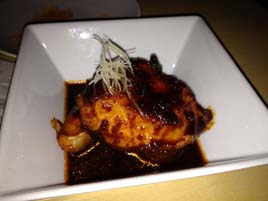
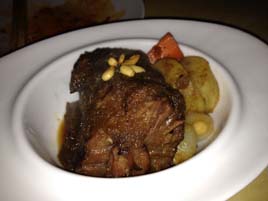
Our second pair of dishes was from the traditional side of the menu. Poached Sablefish ($18; above left) in spicy daikon was flavorful and tender, although the sauce was a bit goopy.
Short Rib ($14; above right), with fingerlings, pearl onions, and toasted pine nuts, may have been the least satisfying: properly cooked short ribs are pretty easy to come by, and this version did little to distinguish itself.
The wine and sake list is short, on the order of twenty-five bottles. The server recommended the 2010 Cuvée Gyotaku Riesling ($38), a Pinot Blanc from Alsace that pairs well with the food. He offered to keep it on ice at the bar, but was too busy to keep tabs when we needed refills.
The reviews here have been all favorable: a Michelin star, one star from Sam Sifton, two stars from Bloomberg’s Ryan Sutton, and four out of five underground stars in New York. The project was obviously assembled with some care (see this blog chronicling its construction).
But Danji has not dealt well with prosperity. The menu has stagnated, and the servers cannot cope with the crowds. Considered on its own, the food is good enough (and inexpensive enough) to be of interest. But I do not think it is worth bothering with, given the hurdles you must jump to get seated. You can do better elsewhere.
Danji (346 W. 52nd Street between Eighth & Ninth Avenues, Hell’s Kitchen)
Food: Traditional and Modern Korean, adequate but not truly exciting
Wine: 25 bottles of wine and sake, well suited to the cuisine
Service: Hostess with an attitude; competent servers stretched to the limit
Ambiance: A cramped, minimalist space, seating 36, many at communal tables
Rating: Not recommended
Why? The food is good enough, but not worth the extremely long waits
 Monday, July 22, 2013 at 01:49PM
Monday, July 22, 2013 at 01:49PM 

 Print Restaurant opened three years ago in the Ink48 Hotel, at Hell’s Kitchen’s most remote address, 48th Street and Eleventh Avenue. There’s nothing wrong with the neighborhood any more, but it’s a loooong hike from the subway.
Print Restaurant opened three years ago in the Ink48 Hotel, at Hell’s Kitchen’s most remote address, 48th Street and Eleventh Avenue. There’s nothing wrong with the neighborhood any more, but it’s a loooong hike from the subway.






























































